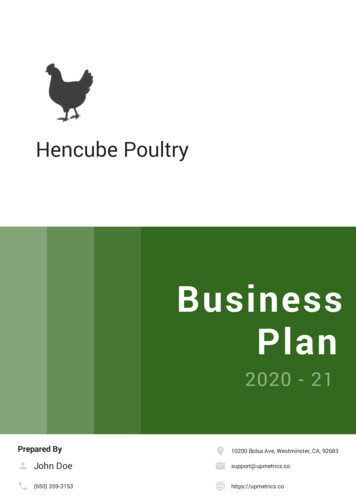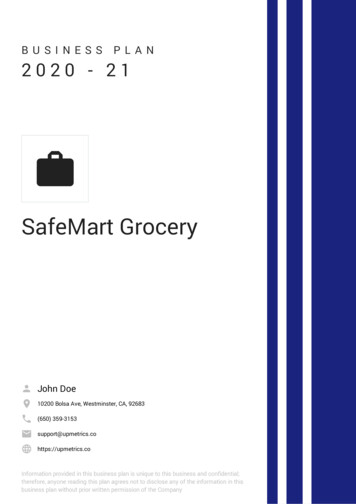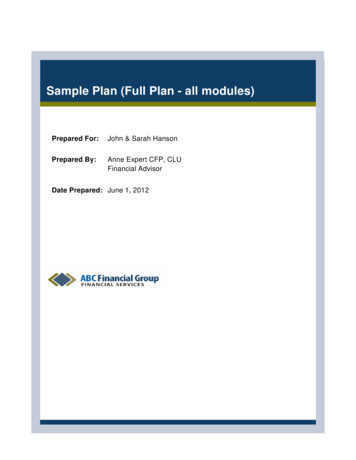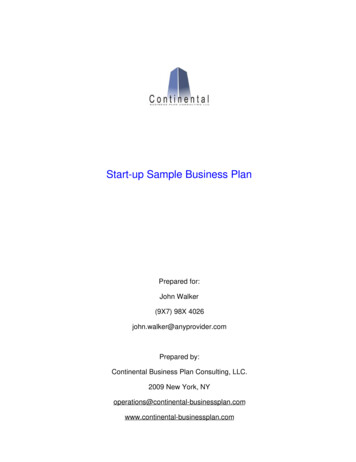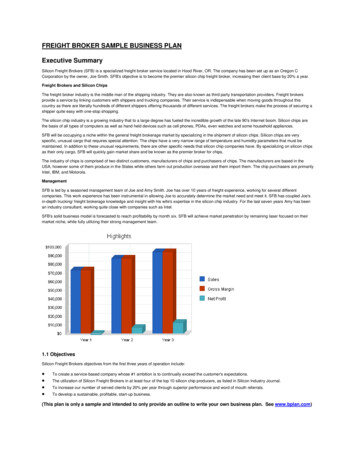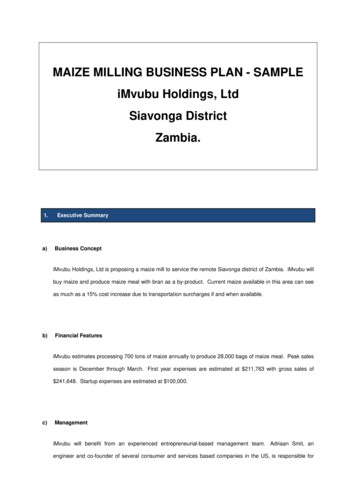
Transcription
MAIZE MILLING BUSINESS PLAN - SAMPLEiMvubu Holdings, LtdSiavonga DistrictZambia.1.Executive Summary1.Executive Summarya)Business ConceptiMvubu Holdings, Ltd is proposing a maize mill to service the remote Siavonga district of Zambia. iMvubu willbuy maize and produce maize meal with bran as a by-product. Current maize available in this area can seeas much as a 15% cost increase due to transportation surcharges if and when available.b)Financial FeaturesiMvubu estimates processing 700 tons of maize annually to produce 28,000 bags of maize meal. Peak salesseason is December through March. First year expenses are estimated at 211,763 with gross sales of 241,648. Startup expenses are estimated at 100,000.c)ManagementiMvubu will benefit from an experienced entrepreneurial-based management team. Adriaan Smit, anengineer and co-founder of several consumer and services based companies in the US, is responsible for
strategic corporate and financial planning. Hein and Melissa Myburgh, long term residents of Zambia with afirm knowledge of the local economy and experience in agricultural management and project infrastructuredevelopment, will run the day-to-day operations. Monica Schoonraad, a South African entrepreneur, investorand business consultant, brings to the table years of milling industry expertise and industry connections.Ownership interest is allocated at 30% to Adriaan Smit, 40% to Hein and Melissa Myburgh and 30% toMonica Schoonraad.d)PartnershipsiMvubu will strive to form mutually beneficial partnerships with local farmers. Farmers will receive morefavorable prices for their crops while iMvubu saves significantly on transportation costs.e)Grant RequestiMvubu is seeking 100,000 in ADM Grant funding. iMvubu will leverage this funding with 280,000 of in-kindcontributions in the form of capital, land, labor and expertise. ADM funding will be applied towards startupcosts. This includes a maize mill and facilities to house the mill and the product inventory. In-kind andadditional funding will be used for inventory purchases and operational expenses. ADM funding will greatlyreduce the financial start-up burdens and provide for a much quicker path to profitability.f)Economic ImpactWith current high maize meal prices and frequent shortages, iMvubu Mill will provide a cheaper product andassure year round availability. Local farmers will also save costs by delivering their crops to a local mill.Similarly more local land owners would be able to farm with a local mill that can buy their product. This willstimulate the local economy and increase Siavonga District cash flow.
2.Business ProfileA.i.The BusinessGoals and ObjectivesMission Statement – iMvubu Holdings, Ltd. will produce maize meal in the remote Siavonga District ofSouthern Zambia in order to reduce the retail price of maize meal in this outlying area.Vision Statement - iMvubu will strive to stimulate and support long term economic growth and increased cashflow in the Siavonga and Chirundu districts.0-18 month goals – This is the startup period where the milling infrastructure will be built. This includesbuilding of facilities, ordering and installation of a maize mill, installation of electricity hookups, procuringmaize sources, and the training of staff on operations and maintenance. Full operation will start during the2011 harvesting season.3 year goals – With positive cash flow iMvubu will turn its focus on growth through community involvement.iMvubu will work with non farming local property owners to encourage commerce and thus gaining additionalmaize sources.5 year goals – Malnutrition is a widespread problem throughout Africa. iMvubu intends to attack this problemdirectly by working with the World Soy Institute and soy expert Dr. M Smit in South Africa to develop a soyprotein enriched maize meal.
ii.Products and ServiceiMvubu Mill will purchase maize and produce maize meal. Maize will be purchased from local andcommercial farmers in any quantities. The maize is typically received bagged in 50kg bags. Maize will bestored until processed. Once processed, the meal will be bagged in 25kg bags and transported for sale. Thegrade of the meal is determined by the finished product’s fineness. Finer meal is typically used for porridgewith a runny consistency while coarse meal is used for a firm and pasty type porridge. Finer meal (calledBreakfast Meal) is generally more expensive but ultimately preferred.iii.Type of BusinessiMvubu Mill is a newly established company, registered in November 2009. iMvubu Holdings Limited, is acorporation with four shareholders who all serve as the board of directors. During operation the mill willrequire 4 to 8 laborers respectively during the off and peak seasons to run at capacity. These workers will behired and trained prior to the completion of the facility. The facility will be located at Plot 10763, Siavonga,Zambia along the Zambezi River. The mill is expected to be fully operational for the 2011 harvesting esaleandretail.
B. The Industryi.Sector DescriptionZambian Milling Sector History - Since maize meal prices we decontrolled during the early 1990’s the millingindustry has enjoyed a much more competitive market structure with smaller milling operations gainingground against prior monopolies.With the eruption of the well known political crisis in Zimbabwe many commercial farmers who lost their farmswhere offered land in Zambia. Two years after the settlement of the initial groups of farmers, Zambiaexperienced its first year of maize surplus.ii.CompetitionThere are two categories of mills in Zambia: small scale mills that only serve their immediate communitiesand large scale mills that sell their product throughout Zambia. With no other local mills, the following largescale mills are considered the only competitors:·National Milling Company (NMC) is the largest milling company in Zambia and has one outlet inSiavonga and another in Chirundu. Deliveries are sporadic at times.·Mpongwe Milling, Antelope Milling, APG Milling, Choma Milling, GBM Milling, Ghirardi Milling, OlympicMilling, Simba Milling, and Superior Milling are located in Lusaka and have no outlets in either Siavongaor Chirundu.·Kapinga Milling is located in Mazabuka. This company divides their product between Mazabuka andLusaka. They produce both roller meal and breakfast meal.
These large scale milling companies are able to spend significantly on marketing and enjoy customerbrand recognition. They are located in areas of established infrastructure and have strong relationships withmaize producers, grain traders and outlets.Large scale milling companies do however struggle to serve remote locations due to transportationcosts. They also process such high volumes that quality is often neglected. Smaller outlets are typicallyignored and customer support is virtually nonexistent.Competitive AdvantageAs the only small scale mill in the Siavonga and Chirundu area, iMvubu Mill offers the following advantagesover competitors:·Location – iMvubu is able to facilitate frequent deliveries assuring constant availability. Being localalso saves transportation costs.·Product Quality – There is currently no quality control enforcement in Zambia. Larger mills dooccasionally produce poor quality meal due to negligence or simply as a result of processing largevolumes of product. Given the manageable size of the iMvubu mill, such quality control can beperformed regularly as needed without any difficulties.·Local Knowledge – Traditional maize marketing channels in Zambia consists of: Producer GrainTrader Milling Agent Retailer Consumer. With iMvubu’s African partner’s close ties with localbusinesses, iMvubu will be able to buy maize without the use of grain traders as well as sell roughly 50%of the product independent of retailers.iii.Market CharacteristicsZambia in general - Maize meal is the staple diet of Southern and Eastern Africa. An average adult inZambia will consume around 120kg of maize meal per year (Chapoto & Jayne, 2006.) Most Zambians, willeat maize meal porridge for breakfast lunch and dinner with various side dishes. In rural parts of Zambia,such that surrounds iMvubu, a bag of maize meal means food security for an average family for two weeksand is their first priority when receiving a salary.
Local Target MarketSiavonga and Chirundu has a combined population of around 12,000 people.people. The surrounding compoundsand villages add 13,000 people while the inhabitants of the villages between the mill and these two townsbring the total population up to around 31,000 people.·Chirundu receives much trough traffic from South Africa and has seen significant growth over the pasteight years. iMvubu will sell directly to both business consumers as well as retail outletsoutle in Chirundu.·Siavonga is located on the shores of Lake Kariba with kapenta fishing and tourism as its economicbases. iMvubu will again sell directly to the fishing and tourism business consumers as well as to retailoutlets.·Other Outlets - There are several small shops in the local area and in route to Siavonga and Chirunduthat can serve as retail outlets and who will benefit from iMvubu’s delivery as they rely on publictransportation to Lusaka to buy stores.
·From the Mill to the Public - iMvubu will also incorporate a small outlet at the mill to supply theimmediate surrounding customers.By-product MarketA maize mill produces bran as a by-product. Not fit for human consumption, maize bran is a nutritiouscomponent of livestock feeds and is even used by some farmers as a complete replacement for expensivelivestock feeds. 20kg Bags of maize bran currently sells for K12,500, which is around 25% of the price of thesame weight in maize meal. The demand for this product is always high in Zambia as animal feeds are veryexpensive and there are many livestock farmers. In Siavonga and Chirundu areas alone there are severalsmall and medium scale cattle and sheep farmers that currently drive to Kafue or Lusaka regularly (up to200kms/125mi away) in order to buy maize bran.iv.Industry DynamicsSales FluctuationsSeasonal Fluctuations - Throughout rural Zambia people plant small areas of maize around their huts tosupply most of their needs. After drying and cleaning the maize they grind it into a meal by hand or withsmall diesel powered milling units called hammer mills, or chigayos. This practice effectively removesthese sustenance farmers from the commercial maize meal demand. However, every year betweenDecember and May there is again a sharp increase in demand for commercially milled maize as thesesustenance farmers once again start relying on commercial meal. This is due to the following tworeasons: Sustenance farmers do not have access to adequate storage facilities for their maize. If thereis a big surplus of maize during the rainy season most or all of it might spoil because of rain andhigh humidity. Many sustenance farmers simply did not grow enough.
The demand for commercial meal once again drops in May every year when people again startharvesting their own crops. During the peak months of December through May most milling companieslook at producing twice as much maize meal per month as they would during the rest of the year.Annual Fluctuations - The milling industry in Zambia has enjoyed a very stable environment over the lastfew years. The main reasons for this stability are: Zambia has one of the most stable and favourable natural climates in Southern Africa forgrowing maize. Droughts and occasional floods along some of Zambia’s main rivers do occurwhich can impact national maize production negatively. On average however, Zambia has beenproducing more and more maize every year for the last eight years. During times of less maize production, and even in times of shortages, maize allocated forhuman consumption receives priority above other maize consuming business sectors like stockfeed production, breweries and of course exports. Prices do increase but are simply reflected inhigher maize meal pricing. This leaves the milling operators largely unaffected by lessavailability of maize.Population Growth and MigrationIt can be accepted that 94% of Zambians consume maize meal as their staple diet. Thenationwide market for maize meal sales can therefore be directly connected with population figures andgrowth rates. The current estimated population of Zambia is 12,620,219 and grows with 2.4% annually.Although it is difficult to quantify this fact without the proper censuses, iMvubu’s African partneris confident that the populations of both Siavonga and Chirundu are constantly on the increase. This isevident in the rapid expansion of housing areas, new businesses and tourist lodges, specifically in theborder town of Chirundu. New businesses stimulate employment and a steady flow of villagers from ruralareas. In these towns however, people are no longer able to farm their own crop and they solely rely oncommercial meal.
v.TrendsGovernment Allocation of MaizeIn times of maize shortage the Zambian government typically first cuts all exports and then reduces theallocation to other business sectors such as stock feed producers and breweries. The Food ReservesAgency is always allocated a portion of maize to keep a buffer in place in case food aid programs mightneed to be implemented during natural disasters like floods or drought.Climate Surrounding Maize Production in ZambiaPolitical Climate - Zambia is one of the few countries in Southern Africa that never had to win itsindependence through warfare. A peaceful transition to independence was granted to Northern Rhodesiaby Great Britain in 1968 when it became the Republic of Zambia under its first president, Mr. KennethKaunda.This peaceful aspect of Zambia’s development as an independent African country is visible in itseconomy today. Zambia and its people do not have a negative outlook on the wes
MAIZE MILLING BUSINESS PLAN - SAMPLE iMvubu Holdings, Ltd Siavonga District Zambia. 1. Executive Summary 1. Executive Summary a) Business Concept iMvubu Holdings, Ltd is proposing a maize mill to service the remote Siavonga district of Zambia. iMvubu will buy maize and produce maize meal with bran as a by-product. Current maize available in this area can see as much as a 15% cost





